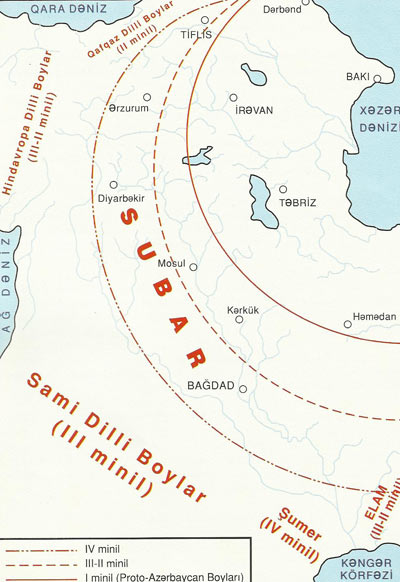Home page
» HISTORY
» States of Azerbaijan
» Front Asia-nation-state
Front Asia-nation-state TRIBES, TRIBAL UNIONS AND STATES IN THE TERRITORY OF MINOR ASIA. (III-II MILLENNIUM BC) Many ancient states were established in the territory of Azerbaijan before Islam and some of them reached the level of the empire. First written sources related to tribes lived then in South Azerbaijan and neighboring lands belong to XXV-XXIII centuries BC and they wrote in Akkadian in Urmia region. But the Turkish power in the territory of Azerbaijan dates back to 4 thousand years BC ago. Sources, especially mention about arattas, quts (qutis), lullubis and khurris. However, according to scientific sources, the first Turkish state established in the territory of South Azerrbaijan is Aratta. Information on Aratta people was noted in Shumer epic. Events between the ruler of Aratta Sukussiranna and the ruler of Shumer Merkar were reflected in that story. The state of Aratta was appeared in the first half of the III millennium BC. Its lands had covered the south and south-eastern part of the Lake Urmia. The modern Qazvin-Zanjan area was also within borders of Aratta. The population of Aratta manufactured gold, lead, copper, mining stones and precious stones and colored stones. They exported their goods to Shumer state, which was dominated between two rivers – the Tigris and the Euphrates. Lullubus were engaged in cattle-breeding and irrigation. Likewise Arratas they were also under strong influence of the Shumer culture. They know cuneiform writing, and they had scholars that could contact Akkadians. The united Lullubu state had been disintegrated in small parts at the II millennium. BC. There were tribal unions in the western and southern-western part of Lake Urmia in III millennium of BC. After second half of same millennium they united as single state. Qutis had alliance with Shumers. But they resisted sharply to the aggressive policy of Akkadians. Quti state was a state formed from tribal unions. It united Turkic tribes like subar, turuk, kuman, bars, bori, gargar,azer, zengi etc. Sources reported that qutis were driven out from Mesopotamia at the end of XXIII century BC. Their power lasted 91 years 40 days. The biggest feature of the Quti state was its governing on democratic basis. In neighboring countries, the power passed from father to son but in qutis the power was elected at assembly, at which “folk elders and “folk” beks participated. The capital of Quti dynasty was present Kirkuk (Arrapha). The names of some Quti elbek (rulers) mentioned in writings of Akkad: Yarlaqab, Yarlaqas, Yarlaqan, Sarlaqab, Elulu (mesh), Inim-Abaqes (in Orkhon-Yenisei monuments Kultigin was addressed as Inim Kultigin), Kurum, Tirikan. It is known that the word qut in Turkish ethimology used in meaning of dominion, success, life, spirit and the name of Avar (turk) ruler being in power in 553 was Kuti-Khan. There are a lot of arguments from history proving Turkic origin of Qutis. There is information about lullubis in the inscriptions of the ruler of Akkad Naramsin. The first written monuments belonged to self of Lullubi rulers relate to the XXIII century BC. If the inscription belonged to King Anubanini, carved in the rock at place called Sarınul is taken as the basis, it becomes clear that Lullubi lands stretched from the lake Urmiya till Basra (Kangar) Gulf. Some historians relate Khurris to 4th biggest and cultural nation of the Asia Minor along with Shumer, Akkadians and Elam in view of possession of writing and written sources at the end of III millennium. From historical facts one can conclude that the state of Mitanni was created by Khurris. And it is certain that Mitannis are descendants of the Turks. Even Lake Urmia was mentioned as Mantiana. It was also mentioned in the sources that Kassu people lived around the Lake Urmiya. One of the most ancient nations of South Azerbaijan was Turks, and among 17 rules that united against Naramsin was a ruler called Illusumel. The geographical area of living of Turukkis stretched from Lake Urmiya to Zanjan. Turukkis acted on the historical scene at the same time of gutis and ullubis. The languages of tribes and other ethnos assumed lived in lands of modern Azerbaijan during late of III millennium BC and early of II millennium BC were united in big language groups named Zaqr-Elam, Zaqros, Kaspi, etc. Some scientists assume that Nah-Dagestani language group belonging to northern–eastern Caucasian language group had affinity to Khurri and Urartu languages. Sami tribes were settled in early of III millennium BC in the north side of the Euphrates and Tigris River. When the political authority of the Ahamenid state of Aryan origin reached the Northern Caucasus Mountains, tribes living in North Azerbaijan had already appeared on the stage of history. The most prominent of them are Kaspis, and the name of the Caspian Sea is their memory. Kaspis are relatives of one of the outstanding people of ancient times Kassis. BC They were mixed inside of Albanian tribes at the end of I millennium. Their residence area was Mugan-Lankaran lowland. The art of navigation was well mastered by Kaspis. Some people assume that part of tribes lived in that period in the territory of Azerbaijan included in Turan system.
|
